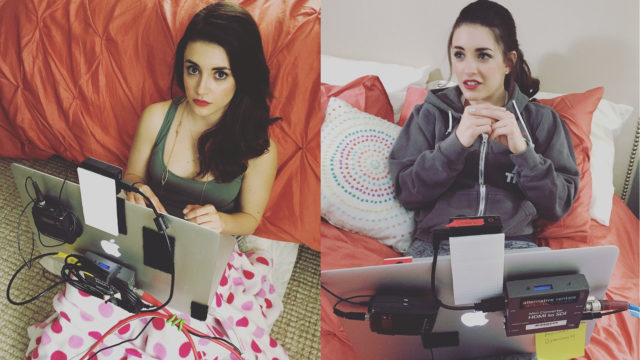Face 2 Face — an Exemplary Screenlife Two-Hander
“Face 2 Face” is what is sometimes called a “two-hander,” related to movies that are often about two people, and focus on their relationship. But “Face 2 Face” stands out by being about a friendship ultimately, and showing the dynamic of that. It relies on performances to guide the way, and uses video calls and screenlife as an honest part of the communication. If it had taken place in the 1990s, it would be over phone calls, but far less cinematic.
Directed by Matthew Toronto and written with his brother Aaron, “Face 2 Face” concerns the rekindled connection of two childhood friends, Teel (Daniel Amerman) and Madison (Daniela Bobadilla). They’re brought together by circumstances that are pretty common in the day of social media, of simply reaching out after a long time, and rekindling. She receives the random message to have a video chat, and it isn’t long before she remembers how they would hang out as kids. Madison even includes Teel in on her adventures of the night, Facetiming while she goes to the party. As he sits at home in his quiet bedroom, she brings the party to him, and it’s just one of many warming gestures that are made in the movie through screenlife communication.
The current day differences are shown to be a dividing factor, creating a natural character tension. Madison has moved to California, and has become popular. It’s a huge contest to Teel, who is still in Michigan, and claims to have no friends. He doesn’t even have a Facebook, and it’s gestures like that continue to isolate him. As they talk over video chat calls, mostly in their bedrooms and with the camera flipping back and forth with the automatic feed of a Skype call, Madison builds an effort to make him more popular, which includes getting a Facebook, and being more outgoing. She especially supports him when he tries out for the school play, another way for him to branch out into a more social life.
Madison is presented as having a pretty happy life, at least in what Teel sees in video chats. She is planning a party for her principal father, and stresses over the perfection of the invitations for the party. Through their casual chats, we get a sense of the pressure she puts on herself and also her life with her father.
Both the storylines of Teel and Madison lead toward big revelations, which come out through their video chats and the presence of a camera. The two of them have secrets that are coaxed out as their friendship grows, and they essentially save each other. All the while, director Matthew Toronto uses the back and forth editing of their video chats, working with long monologues and strong performances from Amerman and Bobadilla. The usage of screenlife creates an intimate environment, but also a space for the actors to work with a range of emotions that are fitting to life but challenging in the acting craft.
The filmmaking crew behind “Face 2 Face” had an interesting and efficient approach to emulating the video chat experience—cameras attached to laptops. Speaking to Talk Nerdy With Us, Toronto shared how “the actors did 99% of the camera work throughout the whole shoot.” The crew attempted to use iPhones for a natural look, but it was the GoPro that made the most sense to the filmmakers. “Ultimately the GoPro gave us more control over settings and some other logistical elements, so we went with that and it worked really well,” Toronto said.

And because the film was made on such a small budget, the shooting schedule was small and relied on the quickness of its actors.
“We shot for about eight days with a pick-up day about a month later. It was extremely fast and we had to be extremely efficient … the actors had to be prepared to shoot whole scenes, some were eight or nine minutes long, in a single take.”
“Face 2 Face” is a movie with a message, and a strong sense of hope. In the growing history of screenlife films, it’s an example of how a film can speak to young viewers both in what its characters talk about, but also in how such a story is told. And it’s also an example of how filmmakers can tell stories with important characters by capturing the reality of video chats, exploring the warm feeling of making a connection with someone even if they’re thousands of miles away.

